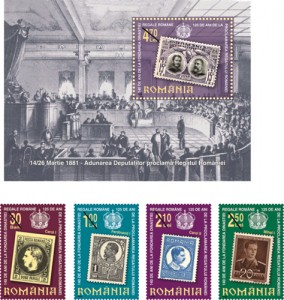 Romfilatelia is now releasing under the title of HISTORICAL EVENTS, a philatelic issue dedicated to the anniversary of 140 years since the Foundation of the Romanian Royal Dynasty and of 125 years since the Proclamation of the Romanian Kingdom.
Romfilatelia is now releasing under the title of HISTORICAL EVENTS, a philatelic issue dedicated to the anniversary of 140 years since the Foundation of the Romanian Royal Dynasty and of 125 years since the Proclamation of the Romanian Kingdom.
Romfilatelia, the company specialized in issuing and trading Romanian postage stamps, is now releasing under the title of HISTORICAL EVENTS, a philatelic issue dedicated to the anniversary of 140 years since the Foundation of the Romanian Royal Dynasty and of 125 years since the Proclamation of the Romanian Kingdom.
On the 5th of January 1859, in Iaºi, Moldavians elected Alexandru Ioan Cuza as ruler, and on the 24th of January, the Elective Assembly of Walachia granted him the same title in this principality. In 1862, on the very same 24th of January, the name of the country becomes Romania, with its capital city in Bucharest. During the following years, Cuza starts a reforming program that will lead to the modernization of the country, but will also create the dissatisfaction of the leading political group. In February 1866, Cuza is forced to abdicate, therefore the idea of bringing a foreign prince to rule the country is adopted again.
The Lordly Lieutenancy created after dismissing Cuza, published "a proclamation to the people", in April 1866, recommending the election, through a plebiscite, of prince Charles of Hohenzollern – Sigmaringen, as the ruler of Romania, under the name of Charles I (1839-1914).
According to the result of the plebiscite, widely favorable to prince Charles, he becomes, on the 10th of May 1866, the Prince of the Romanian United Princedoms.
After only one month, more precisely on the 30th of June 1866, Charles I promulgated the Constitution which, under its 1st article sanctifies the name of the country as follows: "Prince of the Romanians by the grace of God and through our national will; hail to you all, present and future!… The Romanian United Princedoms are now a single, undivided State, called Romania."
In 1869 he married Elisabeth of Wied, also known by her literary pseudonym Carmen Sylva.
Ever since his coming, Charles I militated for the achievement of the national desideratum: to gain the independence and sovereignty of Romania. The Russian-Turkish war that began in the spring of year 1877, as well as Russia´s request that the Romanian armies join the Russian ones, gave the occasion to the Parliament of the country to proclaim, on the 9th of May 1877, the independence of the Romanian State.
Romania´s affirmation as an independent European country imposed the change of its status of Princedom.
In this context, in 1881, on the 26th of March, Charles I received the title of King and Romania becomes Kingdom. After proclaiming the Kingdom, Charles I appointed Ferdinand, the second son of his elder brother, as the heir of the throne. Thus assuring the continuity of the Hohenzollern-Sigmaringen Dynasty, whose name is transformed, starting with King Ferdinand I, into "Casa de Romania". After Ferdinand I (the Unifyer), the throne was inherited by his son, King Charles II and his nephew, son of Charles II, King Michael I of Romania.
During the 48 years of the reign of Charles I, Romania crossed a period of outstanding development in the economic, social and cultural fields, witnessing at the same time a consolidation of the democratic institutions of the State.
The issue, composed of four postage stamps (also prepared as a philatelic block with the Peleº Castle on the background) and a perforated miniature sheet, reunites, in a unitary graphics, representative images of postage stamps belonging to the first series issued with the effigy of each of the four kings: Charles I (1866), Ferdinand I (1920), Charles II (1930), Michael I (1940).
The postage stamp of the miniature sheet reproduces one of the ten postage stamps of the jubilee series "40 years of reign of Charles I" (1906) that reunites the effigies of Charles I as ruler and king.
Issue date: 2006-05-08


